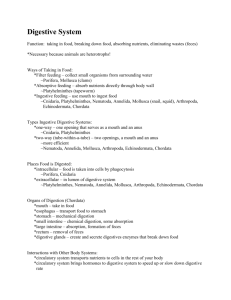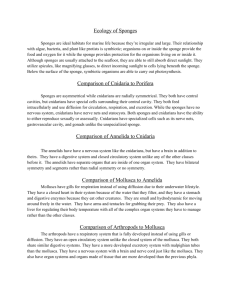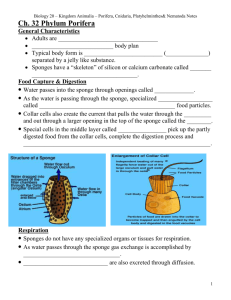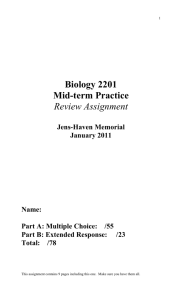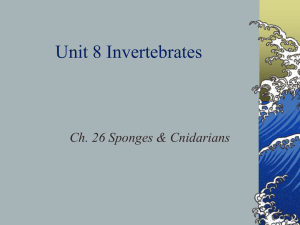Invertebrates 2 Cladograms Cladograms Cladograms Cladistics
advertisement
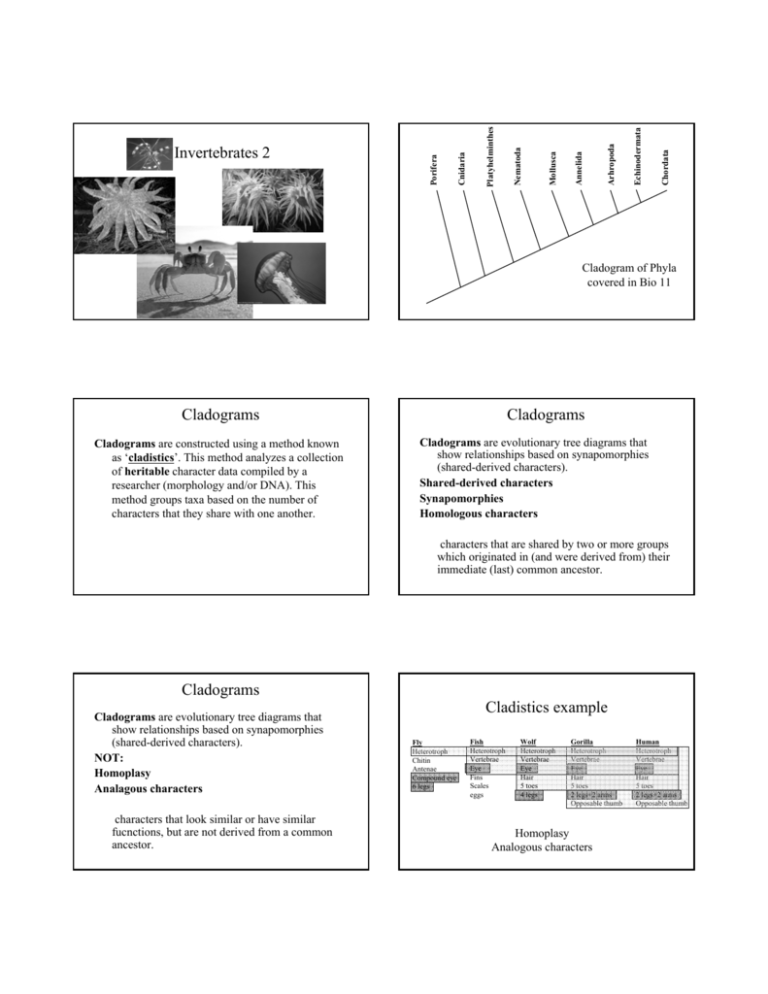
Chordata Echinodermata Arhropoda Annelida Mollusca Nematoda Platyhelminthes Cnidaria Porifera Invertebrates 2 Cladogram of Phyla covered in Bio 11 Cladograms Cladograms are constructed using a method known as ‘cladistics’. This method analyzes a collection of heritable character data compiled by a researcher (morphology and/or DNA). This method groups taxa based on the number of characters that they share with one another. Cladograms Cladograms are evolutionary tree diagrams that show relationships based on synapomorphies (shared-derived characters). Shared-derived characters Synapomorphies Homologous characters characters that are shared by two or more groups which originated in (and were derived from) their immediate (last) common ancestor. Cladograms Cladograms are evolutionary tree diagrams that show relationships based on synapomorphies (shared-derived characters). NOT: Homoplasy Analagous characters characters that look similar or have similar fucnctions, but are not derived from a common ancestor. Cladistics example Fly Heterotroph Chitin Antenae Compound eye 6 legs Fish Heterotroph Vertebrae Eye Fins Scales eggs Wolf Heterotroph Vertebrae Eye Hair 5 toes 4 legs Gorilla Heterotroph Vertebrae Eye Hair 5 toes 2 legs+2 arms Opposable thumb Homoplasy Analogous characters Human Heterotroph Vertebrae Eye Hair 5 toes 2 legs+2 arms Opposable thumb Body Symmetry and Cephalization General Characteristics 1. Body Symmetry 2. Cephalization 3. Type of Gut 4. Type of Body Cavity 5. Segmentation Radial – body parts are Bilateral – right half and left half are mirror images. arranged regularly Anterior/Posterior – head/tail around a central axis. (example: sea anemone) Dorsal/Ventral – back/stomach Examples of Body Symmetry Radial Echinoderm symmetry Bilateral What about sea stars and sea urchins? As adults they have pentameral symmetry which is a form of radial symmetry, but their larvae show bilateral symmetry and molecular data indicates that their ancestors had bilateral symmetry. So we consider them to be bilaterians. Types of Guts Cephalization Sac-like Gut Bilateral organisms have developed a head in the anterior (front) end. This may have been favorable when moving forward and being able to detect and eat what’s in front of them. Many sensory and nerve cells have become concentrated in the head. Tube-like Gut Mouth Single opening for ingesting food and excreting wastes. Anus Complete gut with mouth and anus. Food travels oneway through the organism. Types of Body Cavities in Animals Types of Body Cavities in Animals Coelom Lined body cavity Acoel - no body cavity Pseudocoel - unlined body cavity Segmentation Repeating series of body units that may be quite different. Examples: Segments of an earthworm are similar. Segments of a crustacean are different (lobster, insect). Fossils Fossile evidence has provided a greart deal of information about the origins of extant taxa. Ediacaran Fossils 600600-542 million years Also called “Vendian” Vendian” South Australia Spriggina Ediacara Hills, Australia Dickensonia Burgess Shale Ediacaran Assemblage • Yoho National Park • Canadian Rockies • ~540 mya Burgess Shale View from the Quarry Working the Burgess Shale Helena Walcott & family, ca. 1910? Charles Walcott in his seventies Royal Ontario Museum camp, August 2000, near Walcott’ Walcott’s campsite Burgess Shale Edge of the Quarry Discovery of Burgess Fossils Walcott’ Walcott’s Field Notes Burgess Shale Burgess Shale Slabs Ready to Split for Fossils Prepared Burgess Fossils Trilobite Freshly Exposed Fossils Burgess Animals Arthropoda Canadia Canadaspis Sanctacaris Anomolacarus Arthropod Annelid Polychaete worm Figure from: Starr, C. (2000). Biology, Concepts and Applications. Brooks/Cole. Yohoia Marella Opabinia Burgess Animals Burgess Animals Weird Phyla Onychophora Chordata Annelida Nectocaris Hallucigenia Dinomischus Canadia Wiwaxia Chordata Echinodermata Arhropoda Annelida Mollusca Cnidaria Porifera The Burgess Sea Nematoda Aysheaia Platyhelminthes Pikaia Cladogram of Phyla covered in Bio 11 Figure from: Starr, C. (2000). Biology, Concepts and Applications. Brooks/Cole. Origin of Multicellularity Key Points for Each Phylum: • Recognize them • Where they fall in the overall phylogenetic tree • General Body Plan: symmetry, gut, coelom, skeleton Animals choanoflagellate-like protists Two hypotheses 1. Ciliates One cell, many nuclei 2. Colonies • General lifestyle Colonies of cells that became specialized for certain tasks Chordata Echinodermata Arhropoda Annelida Mollusca Nematoda Platyhelminthes Cnidaria Porifera Chordata Echinodermata Arhropoda Annelida Mollusca Nematoda Platyhelminthes Cnidaria Porifera Radial symmetry Snails, Octopus, squid, clams,chitons, nudibranchs • Bilateral symmetry • many tissue types • Organ system Arhropoda Echinodermata Chordata Echinodermata Chordata Annelida Mollusca Annelida Mollusca Platyhelminthes Cnidaria Porifera Chordata Echinodermata Bilateral symmetry Nematoda Roundworms • Bilateral symmetry • Several tissue types • Organ system Arhropoda Annelida Mollusca Nematoda Platyhelminthes Cnidaria Nematoda Bilateral symmetry Flatworms • Bilateral symmetry • Tissues • simplest organ system Porifera Arhropoda Bilateral symmetry Platyhelminthes Cnidaria Porifera Chordata Echinodermata Jelly fish, corals, sea anemones • Radial symmetry • Simple tissues • No organs Arhropoda Annelida Mollusca Nematoda Platyhelminthes Cnidaria Porifera Sponges • Basal to all animals • no symmetry • no tissues or organs Bilateral symmetry Segmented worms, Earthworm • Bilateral symmetry • Tissues • Organ system Chordata Echinodermata Porifera (Sponges) Success in Simplicity • • • • • • Bilateral symmetry No symmetry, tissues, or organs Abundant since Precambrian 8000 species today “Filter” food from the water Sessile adults Silica spicules •General lifestyle: Marine filter feeders Mammals, reptiles, birds, fish • Bilateral symmetry • Complex Tissues • Complex organ systems Porifera Structural Elements of Sponges A sponge releasing a cloud of sperm Most live in coastal, shallow water marine environments Some deep ocean or fresh water Hermaphrodites that reproduce sexually (most species) Sperm in water, but eggs retained until fertilized Swimming larval stage Spicule types Chordata Echinodermata Arhropoda Annelida Starfish, sea urchins, sea cucumbers • Bilateral symmetry • Tissues • Organ system Arhropoda Annelida Mollusca Nematoda Platyhelminthes Cnidaria Mollusca Bilateral symmetry Crustaceans, Insects • Bilateral symmetry • Tissues • Organ system Porifera Nematoda Platyhelminthes Cnidaria Porifera Chordata Echinodermata Arhropoda Annelida Mollusca Nematoda Platyhelminthes Cnidaria Porifera Bilateral symmetry Sponges – Skeletal Elements Sponges Venus’s flower basket (Euplectella) Tethya aurantia puffball sponge Figure 23.7 (c,d) from page 361 of your text Sponges Sponges Acarnus erithacus red volcano sponge Spheciospongia confoederata moon sponge Sponges Sponges Coral Reef Spheciospongia confoederata close-up moon sponge Vase Sponge Chordata Echinodermata Arhropoda Annelida Mollusca Nematoda Platyhelminthes Cnidaria Porifera Radial symmetry Jelly fish, corals, sea anemones Phylum Cnidaria – anemones, corals, jellies 1. Key Innovations are radial symmetry and a tissue-level of organization (still no organs) 2. Diploblastic – have only two embryonic tissues (ectoderm and endoderm) 3. Have a sac-like gut 4. Two body forms – polyp and medusa polyp is sessile and benthic, medusa is planktonic 5. Carnivores with one gut opening 6. Reproduce sexually and asexually (budding) Cnidarian Reproduction Cnidarian Body Forms reproductive polyp female medusa ovum one branch polyp from a mature branching forming colony medusa Cnidarians Phylum Cnidaria Cnidocytes Cells containing a stinging structure (nematocyst). sperm zygote feeding polyp polyp male medusa Hollow thread Delivers venom Trigger (cnidocil) Barbed tube nematocyst Cnidocyte (cell) Sea wasp warning sea wasp warning planula Cnidarians Cnidarians - cnidocysts hydroid Jellyfish stings Cnidarians Cnidarians Lytocarpus philippinus stinging hydroid Millepora – fire coral Cnidarians Cnidarians Portuguese Man O’ War (Physalia physalis) Millepora – fire coral close-up Cnidarians Cnidarians close-up of tentacles of Portuguese Man O’ War (Physalia physalis) Urticina lofotensis rose colored anemone Cnidarians Cnidarians Cnidaria coral skeletons corals from the Great Barrier Reef Cnidarians Cnidarians Tubastrea tropical coral cup coral close-up Cnidarians Cnidarians symbiotic zooxanthellae (dinoflagellate) in coral tentacle Echinophyllia aspera (gray coral) close-up Cnidarians Cnidarians soft coral gorgonian (sea fan) Cnidarians Cnidarians gorgonian close-up (sea fan) gorgonians (sea fans) notice polyps Cnidarians Cnidarians Chrysaora fuscescens Sea nettle jelly Chrysaora fuscescens sea nettle jelly Cnidarians Cnidarians Chrysaora (Pelagia) colorata Purple-striped jelly Exam on Friday! We will have fewer questions! Review session tonight at 5:30 in 2301 Tolman. Chironex fleckeri sea wasp
